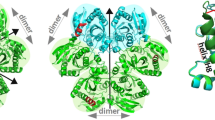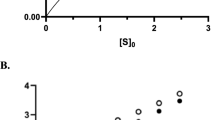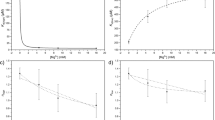Abstract
BOTH Gunsalus et al. 1 and Wada et al. 2 have reported that the presence of glutathione is advantageous during the assay of tryptophanase preparations. Wada et al. have also reported studies on the inhibition of tryptophanase by a number of SH-group reagents, and have suggested that the group is involved in the linkage between apoenzyme and substrate3. When we compare results which we have obtained at intervals since 1942, there is much agreement between us, but divergences, which may or may not be significant, do exist. Evans, Handley and Happold4 reported a 12–20 per cent reduction of activity in washed cell preparation with sodium iodoacetate in a final concentration of M/33, and in later work with cell-free preparations activities were reduced by 20–25 per cent at concentrations of 5 × 10−3 M. At lower concentrations 5 × 10−5 and 10−6 M there has been no inactivation or even from time to time an apparent increase in the activity of the preparations. Further studies on, inhibition were reported by Dawes and Happold5. Such preparations of tryptophanase are not necessarily free from other enzymes associated with pyridoxal phosphate-linked enzyme systems nor from the system which produced pyridoxal phosphate from pyridoxamine phosphate which Beechey and Happold described as a transaminase and which we now know contains a pyridoxamine phosphate oxidase similar to that found by Pogell in rabbit liver preparations; these divergences may be significant. During work in these laboratories on the purification of tryptophanase, the inhibition of activity by the SH-group alkylating reagent chloroacetophenone, and the reversal of SH-group inactivation, have been studied.
This is a preview of subscription content, access via your institution
Access options
Subscribe to this journal
Receive 51 print issues and online access
$199.00 per year
only $3.90 per issue
Buy this article
- Purchase on Springer Link
- Instant access to full article PDF
Prices may be subject to local taxes which are calculated during checkout
Similar content being viewed by others
References
Gunsalus, I. C., Galeener, C. C., and Stamer, J. R., “Methods in Enzymology”, 2, 238 (Acad. Press, 1955).
Wada, H., Morisue, T., Sakamoto, Y., and Ichihara, K., J. Vitaminol. (Japan), 3, 183 (1957).
Wada, H., et al., Proc. Internat. Symp. on Enzym. Chem., Tokyo and Kysto, 1957 (Pergamon Press, 1958).
Evans, W. C., Handley, W. R. C., and Happold, F. C., Biochem. J., 36, 311 (1942).
Dawes, E. A., and Happold, F. C., Biochem. J., 44, 349 (1949).
Beechey, R. B., and Happold, F. C., Biochem. J., 66, 520 (1957).
Author information
Authors and Affiliations
Rights and permissions
About this article
Cite this article
TURNER, J., HAPPOLD, F. Effect of Sulphydryl Group Reagents on Tryptophanase Activity. Nature 185, 763–764 (1960). https://doi.org/10.1038/185763a0
Issue Date:
DOI: https://doi.org/10.1038/185763a0
This article is cited by
-
Untersuchungen �ber den Einflu� von R�ntgenstrahlen auf Pyridoxalphosphat in Escherichia coli
Archiv f�r Mikrobiologie (1963)
Comments
By submitting a comment you agree to abide by our Terms and Community Guidelines. If you find something abusive or that does not comply with our terms or guidelines please flag it as inappropriate.



